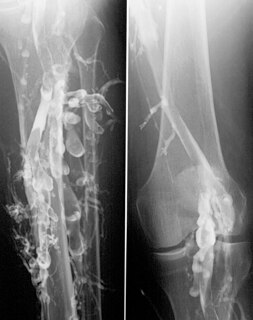Venous insufficiency can refer to:
| This disambiguation page lists articles associated with the title Venous insufficiency. If an internal link led you here, you may wish to change the link to point directly to the intended article. |
Venous insufficiency can refer to:
| This disambiguation page lists articles associated with the title Venous insufficiency. If an internal link led you here, you may wish to change the link to point directly to the intended article. |

Varicose veins are superficial veins that have become enlarged and twisted. Typically they occur just under the skin in the legs. Usually they result in few symptoms but some may experience fullness or pain in the area. Complications may include bleeding or superficial thrombophlebitis. When varices occur in the scrotum it is known as a varicocele while those around the anus are known as hemorrhoids.

The jugular veins are veins that take deoxygenated blood from the head back to the heart via the superior vena cava.

Angiology is the medical specialty which studies the diseases of the circulatory system and of the lymphatic system, i.e., arteries, veins and lymphatic vessels, and its diseases.
ICD-10 is an international statistical classification used in health care and related industries.

Dalteparin is a low molecular weight heparin. It is marketed as Fragmin. Like other low molecular weight heparins, dalteparin is used for prophylaxis or treatment of deep vein thrombosis and pulmonary embolism. It is normally administered by self-injection.

Diosmin, a flavone glycoside of diosmetin, is manufactured from citrus fruit peels as a non-prescription dietary supplement used to aid treatment of hemorrhoids or chronic venous diseases, mainly of the legs.
Placental insufficiency or utero-placental insufficiency is the failure of the placenta to deliver sufficient nutrients to the fetus during pregnancy, and is often a result of insufficient blood flow to the placenta. The term is also sometimes used to designate late decelerations of fetal heart rate as measured by electronic monitoring, even if there is no other evidence of reduced blood flow to the placenta, normal uterine blood flow rate being 600mL/min.

Venography is a procedure in which an x-ray of the veins, a venogram, is taken after a special dye is injected into the bone marrow or veins. The dye has to be injected constantly via a catheter, making it an invasive procedure. Normally the catheter is inserted by the groin and moved to the appropriate site by navigating through the vascular system.

Chronic venous insufficiency (CVI) is a medical condition in which blood pools in the veins, straining the walls of the vein. The most common cause of CVI is superficial venous reflux which is a treatable condition. As functional venous valves are required to provide for efficient blood return from the lower extremities, this condition typically affects the legs. If the impaired vein function causes significant symptoms, such as swelling and ulcer formation, it is referred to as chronic venous disease. It is sometimes called chronic peripheral venous insufficiency and should not be confused with post-thrombotic syndrome in which the deep veins have been damaged by previous deep vein thrombosis.
Zamboni or The Zamboni may refer to:
Heavy legs is an alleged medical condition, described as an "unpleasant sensation of pain and heaviness" in the lower limbs. It is of French origin but is occasionally seen elsewhere.
Insufficiency may refer to:

Chronic cerebrospinal venous insufficiency is a term developed by Italian researcher Paolo Zamboni in 2008 to describe compromised flow of blood in the veins draining the central nervous system. Zamboni hypothesized that it played a role in the cause or development of multiple sclerosis (MS). Zamboni also devised a procedure which was termed by the media as "liberation procedure" or "liberation therapy", involving venoplasty of certain veins in an attempt to improve blood flow.
Hydroxyethylrutosides are hydroxyethyl derivatives of rutosides. Examples include:
Daflon is a micronized purified flavonoid fraction containing 90% diosmin and 10% other flavonoids expressed as hesperidin. It is manufactured by Laboratoires Servier.
Corona phlebectatica is a cutaneous sign of chronic venous insufficiency, characterized by abnormally dilated veins around the ankle. It is characterised by the presence of abnormally visible cutaneous blood vessels at the ankle with (a) venous cups, (b) blue and red telangiectasis, and (c) capillary stasis spots. It was proposed that the presence of corona phlebectatica be included in current clinical classifications of chronic venous disorders.

Ultrasonography of suspected or previously confirmed chronic venous insufficiency of leg veins is a risk-free, non-invasive procedure. It gives information about the anatomy, physiology and pathology of mainly superficial veins. As with heart ultrasound (echocardiography) studies, venous ultrasonography requires an understanding of hemodynamics in order to give useful examination reports. In chronic venous insufficiency, sonographic examination is of most benefit; in confirming varicose disease, making an assessment of the hemodynamics, and charting the progression of the disease and its response to treatment. It has become the reference standard for examining the condition and hemodynamics of the lower limb veins.

Claude Franceschi is an angiologist French MD.
A lower limbs venous ultradonography may refer to:
CHIVA method is a type of surgery used to treat varicose veins that occur as a result of long term venous insufficiency. The term is a French acronym for Conservatrice Hémodynamique de l'Insuffisance Veineuse en Ambulatoire.